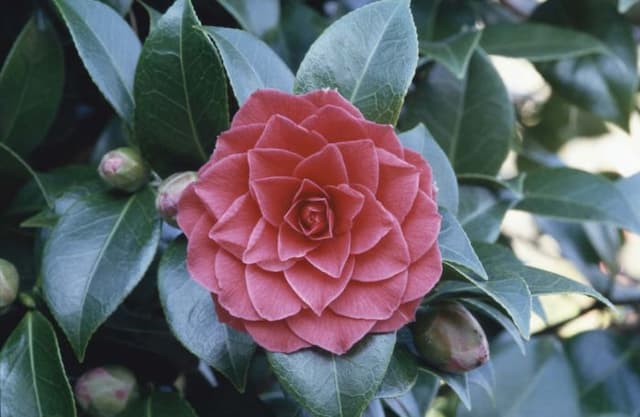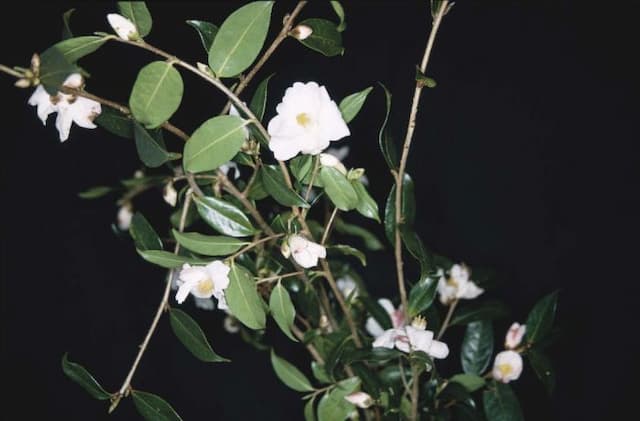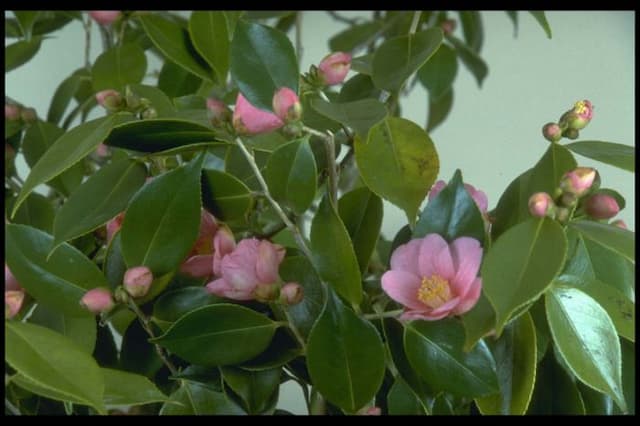ShiShi Gashira Camellia Camellia hiemalis 'Shishigashira'

ABOUT
The Camellia hiemalis 'Shishigashira', also commonly known as the 'Shishi Gashira' sasanqua, is a visually stunning plant characterized by its lustrous, leathery dark green leaves. These leaves are typically small with a somewhat serrated edge, giving them a distinct and slightly textured appearance. The plant is renowned for its beautiful flowers, which bloom in the cooler months. These blossoms are quite notable, with a dense cluster of petals that can appear almost ruffled. The flowers are a deep pink to a rosy red color, adding splashes of vibrant hues to the garden landscape when many plants are not in bloom. The 'Shishi Gashira' sasanqua is often appreciated for its semi-double to double flowers that may exhibit a more intense coloration at the petal edges or possess a gradient of tones from the center outwards. With a robust, bushy growth habit, this plant contributes a lush, verdant presence wherever it is situated.
About this plant
 Names
NamesFamily
Theaceae
Synonyms
Shishigashira Camellia, Lion's Head Camellia
Common names
Camellia hiemalis 'Shishigashira'.
 Toxicity
ToxicityTo humans
The Japanese camellia is generally not considered toxic to humans. Ingesting parts of the plant typically does not lead to severe poisoning. However, it is always advisable to avoid consuming parts of ornamental plants due to the potential for mild gastrointestinal upset or irritation.
To pets
The Japanese camellia is also not considered highly toxic to pets. However, if a pet were to ingest a large amount of the plant, they might experience mild gastrointestinal discomfort, such as vomiting or diarrhea. It is always best to keep an eye on pets and prevent them from eating ornamental plants as a precaution.
 Characteristics
CharacteristicsLife cycle
Perennials
Foliage type
Evergreen
Color of leaves
Dark green
Flower color
Pink
Height
4-5 feet (1.2-1.5 meters)
Spread
3-4 feet (0.9-1.2 meters)
Plant type
Shrub
Hardiness zones
7
Native area
Japan
Benefits
 General Benefits
General Benefits- Ornamental Value: Camellia hiemalis 'Shishigashira', commonly known as Sasanqua camellia, offers aesthetic appeal with its glossy green leaves and attractive flowers that bloom in various colors, enhancing the visual interest of landscapes and gardens.
- Long Blooming Season: Sasanqua camellias generally have a longer blooming season compared to other camellias, providing color and vibrancy from fall to winter when few other plants are in bloom.
- Drought Tolerance: Once established, this variety of camellia is tolerant of dry conditions, making it suitable for regions with water restrictions or for gardeners seeking low-water-use plants.
- Compact Growth: The 'Shishigashira' cultivar tends to have a compact and dense growth habit, making it an excellent choice for smaller gardens, hedges, or as a container plant where space is limited.
- Shade Tolerance: Sasanqua camellias can thrive in partial shade, allowing them to be planted in diverse garden settings that may not receive full sun, thereby increasing their versatility in landscape design.
- Wildlife Attraction: The flowers of the Sasanqua camellia attract pollinators such as bees and can also provide a source of food for birds, thus supporting local ecosystems and biodiversity.
- Low Maintenance: Sasanqua camellias are known for their low maintenance needs, requiring minimal pruning and care once established, which is ideal for gardeners of all skill levels.
 Medical Properties
Medical PropertiesThis plant is not used for medical purposes.
 Air-purifying Qualities
Air-purifying QualitiesThis plant is not specifically known for air purifying qualities.
 Other Uses
Other Uses- The tightly-packed, twisted foliage of Sasanqua can be used in bonsai cultivation, offering a miniature landscape aesthetic.
- Sasanqua leaves can be used as natural mulch for garden beds, decomposing to enrich the soil with nutrients.
- Floral arrangements can be elevated with the addition of Sasanqua flowers, providing a unique texture and vibrant color.
- During festive seasons, Sasanqua can be utilized as a natural decoration, with its bright flowers creating a beautiful display.
- The plant's dense growth habit makes it suitable for creating privacy hedges or screens in gardens and landscapes.
- Sasanqua branches can be shaped into wreaths and garlands for decorative purposes during holiday seasons.
- With its attractive form, Sasanqua is often used in topiary art, allowing gardeners to sculpt living works of art.
- Educational resources often use Sasanqua as a case study to teach about plant growth patterns, flowering periods, and care.
- Photography enthusiasts might use Sasanqua as a captivating subject for nature photography due to its striking flowers.
- Artists and illustrators may take inspiration from the intricate shapes of Sasanqua flowers for designs in textiles or wallpaper patterns.
Interesting Facts
 Feng Shui
Feng ShuiThe Shishigashira Camellia can be used in Feng Shui to create a balanced and harmonious environment. It's wood element can enhance personal growth and vitality when placed in the east area of a garden or home. Its lush foliage and vibrant flowers can also attract positive chi and are particularly beneficial when placed in the southeast to attract wealth and abundance.
 Zodiac Sign Compitability
Zodiac Sign CompitabilityThe Shishigashira Camellia is not used in astrology practice.
 Plant Symbolism
Plant Symbolism- Perfection: The Camellia is often associated with the ideal of perfection due to its lush blooms and symmetrical form, suggesting completeness and flawlessness.
- Admiration: Giving someone a Camellia is a way to express your genuine admiration and respect for them, as the camellia's beauty can represent the beautiful qualities of a person.
- Long-lasting Love: The sturdy nature of the Camellia flower, along with its long blooming season, symbolizes long-lasting love and devotion in a relationship.
- Refinement: With its elegant appearance, the Camellia represents refinement and is often associated with polished and sophisticated behaviors.
 Water
WaterFor the Shi Shi Gashira Camellia, it is important to maintain consistent moisture without overwatering. Water the plant thoroughly when the top inch of soil begins to feel dry to the touch, which typically equates to once a week during growing season. If you're watering potted plants, ensure the container has proper drainage and give about 1 gallon of water per watering session for a medium-sized pot. Reduce watering frequency to every two to three weeks during the winter dormancy period or if rainfall suffices. Avoid letting the plant sit in waterlogged soil, as this can lead to root rot.
 Light
LightShi Shi Gashira Camellias thrive best in partial shade where they receive filtered sunlight or morning sun with afternoon shade. Avoid placing them in full afternoon sun, especially in hotter climates, as this can stress the plant and burn its leaves. A spot near a north- or east-facing wall or under light tree canopy is ideal to protect the camellias from harsh sun exposure.
 Temperature
TemperatureShi Shi Gashira Camellias prefer temperate climates with temperatures that generally range between 40 to 85 degrees Fahrenheit. They can withstand brief dips below this range, down to about 20 degrees Fahrenheit, but prolonged exposure to extreme cold or heat can be detrimental. For optimal growth and bloom production, maintain temperatures within the ideal range and protect the plant from frost.
 Pruning
PruningPrune Shi Shi Gashira Camellias to maintain shape and encourage healthy growth, removing any dead or weak branches. The best time for pruning is after the plant has finished blooming, usually in late winter or early spring. Light pruning annually or biennially can help open the plant's interior to light and air circulation, which is beneficial for its vitality. Thinning out crowded branches can enhance the plant's natural form and increase flower production.
 Cleaning
CleaningAs needed
 Soil
SoilThe best soil mix for a Camellia ShiShi Gashira is well-draining, rich in organic matter, slightly acidic to neutral pH between 5.5 and 6.5. A mixture of potting soil, peat moss, and perlite in equal parts can help create the ideal growing conditions for this camellia variety.
 Repotting
RepottingCamellia ShiShi Gashira should be repotted every 2 to 3 years in spring after blooming. Choose a pot only slightly larger than the current one to ensure the best growth environment.
 Humidity & Misting
Humidity & MistingCamellia ShiShi Gashira prefers high humidity levels, ideally between 40% to 60%. It thrives when the air is moist but not saturated, which helps maintain healthy growth and bloom.
 Suitable locations
Suitable locationsIndoor
Place in bright, filtered light, and maintain high humidity.
Outdoor
Partial shade, protect from strong winds, well-draining soil.
Hardiness zone
7-9 USDA
 Life cycle
Life cycleThe plant commonly known as 'Shishigashira' Camellia begins its life cycle as a seed, germinating in favorable conditions of warmth and moisture. Once sprouted, the seedling grows into a juvenile plant, developing a strong root system and foliage. It reaches maturation in several years, characterized by the capacity to flower and reproduce; the 'Shishigashira' produces dense, irregularly arranged pink to rose-red blossoms typically in the fall to winter months. After pollination, usually by insects, the flowers form seed pods that eventually dry and release seeds, completing the reproductive cycle. The plant continues to grow vegetatively even when not reproducing, potentially living for many decades and reaching a mature height of 6-10 feet with a spread of 5-7 feet. As an evergreen, it maintains its glossy, dark green leaves throughout the year, only shedding them as they age and are replaced by new growth.
 Propogation
PropogationPropogation time
Early spring
Camellia hiemalis 'Shishigashira', commonly known as the 'Shishigashira' Camellia, is best propagated through semi-hardwood cuttings. This method is most effective during the late summer or early fall. To propagate, a cutting of about 4 to 6 inches (approximately 10 to 15 centimeters) long is taken from a healthy parent plant. The leaves on the lower half of the cutting are removed, and the cut end is treated with a rooting hormone to enhance root development. The cutting is then planted in a well-draining potting mix, ensuring at least two nodes are buried where leaves were removed. This encourages roots to form from the nodes. The pot is kept in a warm, humid environment away from direct sunlight until the cutting has rooted, which can take several weeks.









